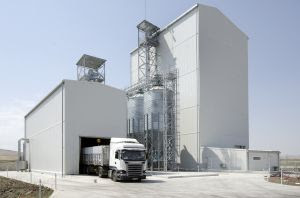
Available in other languages:
Content available at:
Português (Portuguese (Brazil))
Aviagen’s global expert, Richard Obermeyer, shares advice for reducing the occurrence of pathogens before they can enter the food chain.

The four steps to biosafety at the poultry feed mill are:
Step 1: Keep equipment and environments dry
There are many vectors for the transfer of pathogens, and water is one of them. The biosafe feed processing facility must be kept dry and free of any standing water at all times.
“The presence of standing water must be avoided at all costs, as it becomes a reservoir for bacteria and a large vector for viruses and Salmonella,” he said. “Vehicles drive through water, people step on it, while birds, rodents, and other animals drink from it, and that’s how pathogens spread.”

Another area for potential water-related problems is the feed ingredient receiving area, which must be dry and clean at all times. Covers for the raw material receiving area (hopper) and surrounding areas can be used to help minimize the possibility of water or other materials entering the unloading area. However, they must be monitored and maintained regularly. The hopper should be small enough that the vehicle’s wheels do not come into contact with it, and constructed in a funnel shape to minimize spillage during unloading. Any spills must be cleaned up immediately and before any further movement of the vehicle into the raw material/hopper receiving area.
Finally, it is important that processing and storage areas are adapted to keep rain and moisture away from input processing and storage equipment.
Step 2: Eliminate other pathogen vectors
Dust, rodents, wild birds, vehicles, and pedestrian traffic are also possible propagators of bacteria and viruses.
“Salmonella thrives on organic materials such as dust,” explains Obermeyer, as it provides food and an effective means of possible cross-contamination if contaminated dust enters biosafe areas.
“Rodents, insects, and birds are all hosts for bacteria and viruses,” he adds, as as soon as the pathogens are ingested, they will be disseminated throughout the feed factory. “Once these pests take shelter, it is very difficult to eliminate them completely. Therefore, the main focus must be to keep them at a distance from the beginning.” Open buildings are an invitation for rodents and wild birds to occupy spaces, so they must always be closed and protected with the adoption of adequate procedures for protection against birds and rodents.
The daily flow of people and vehicles can also spread pathogens throughout the feed mill. It is very important to separate vehicles carrying raw materials from all other facilities. “Raw material delivery drivers cannot access the interior of the feed mill,” comments Obermeyer, and they must have a separate waiting area and toilets. The facility must direct the flow of raw material traffic, using signage with specific instructions for drivers and delivery people. Gates, fences, and locked doors also help keep employees and visitors in their respective areas.
Subscribe now to the poultry technical magazine
AUTHORS

Layer Longevity Starts at Rearing
H&N Technical Team
The Strategy for a Proper Infectious Bronchitis Control
Ceva Technical Team
Elevate Hatchery Performance with Petersime’s New Data-Driven Incubation Support Service
Petersime Technical Team
Maize and Soybean Meal Demand and Supply Situation in Indian Poultry Industry
Ricky Thaper
Production of Formed Injected Smoked Chicken Ham
Leonardo Ortiz Escoto
Antimicrobial Resistance in the Poultry Food Chain and Novel Strategies of Bacterial Control
Edgar O. Oviedo-Rondón
GREG TYLER INTERVIEW
Greg Tyler
Insights from the Inaugural US-RSPE Framework Report
Elena Myhre
Newcastle Disease: Knowing the Virus Better to Make the Best Control Decisions. Part II
Eliana Icochea D’Arrigo
Avian Pathogenic E. coli (APEC): Serotypes and Virulence
Cecilia Rosario Cortés
The Importance of Staff Training on Animal Welfare Issues in Poultry Industry
M. Verónica Jiménez Grez
Rodent Control is a Key Factor in Poultry Biosecurity and Sustainability
Edgar O. Oviedo-Rondón